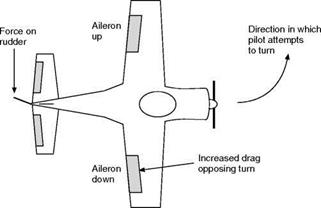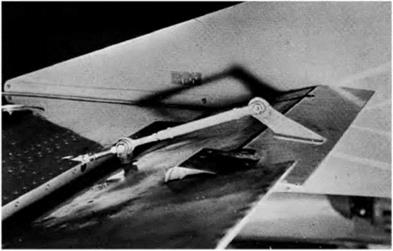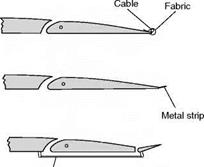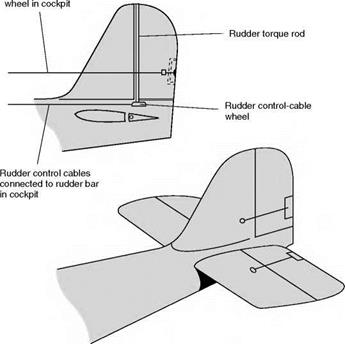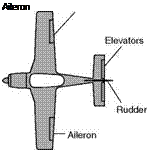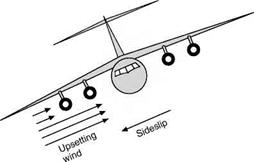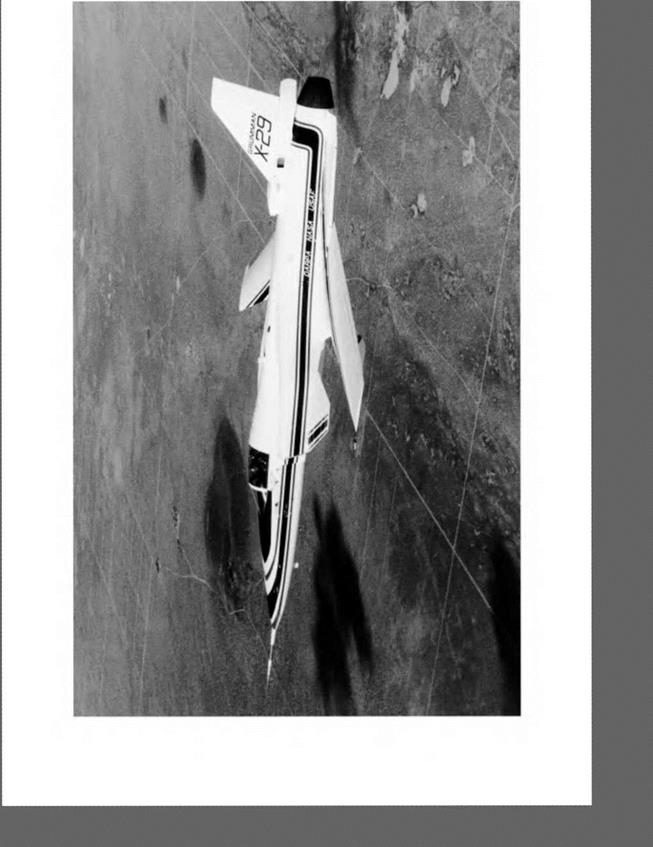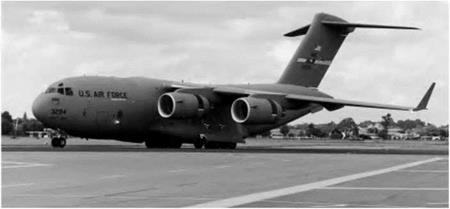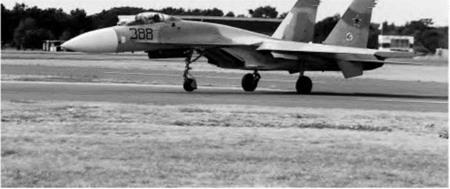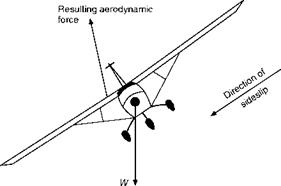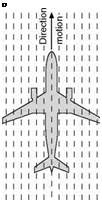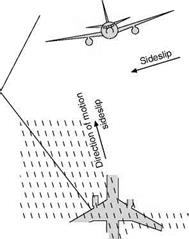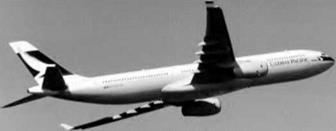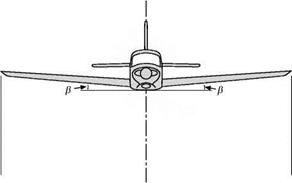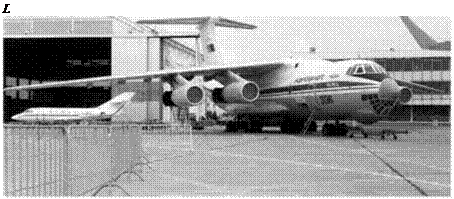Control at low speeds
We now turn our attention to an important and interesting problem – namely, that of control at low speeds or, what amounts to the same thing, at large angles of attack. It is obviously of little use to enable a machine to fly slowly unless we can ensure that the pilot will still have adequate control over it (Fig.
9J).
Let us first state the problem by giving an example. Suppose, owing to engine failure, a pilot has to make a forced landing. If he is inexperienced – and indeed it has been known to happen to pilots of considerable experience
|
|
Fig 9) Control at low speed
The massive bulk of the Antonov AN-124 in a tight turn at low speed and low altitude. This photograph was taken from the ground!
– he will often tend to stall his aeroplane in an attempt to reach a distant field or to climb over some obstacle. Now the use of slots or flaps may postpone the stall, may help him to obtain lift at slow speeds, but they will not give him what he most needs – namely, efficient control.
In the first place, owing to the decreased speed of the airflow over all the control surfaces, the forces acting on them will be less and they will feel ‘sloppy’. But this is not all. Suppose while he is thus flying near the stalling angle he decides that he must turn to the left, he will move the control column over to the left (which will cause the right aileron to go down and the left one to go up), at the same time applying left rudder. The rudder will make a feeble effort to turn the aeroplane to the left; but what will be the effect of the movement of the ailerons?
The effect of the right aileron going down should be to increase the lift on the right wing, but in practice it may decrease it, since it may increase the angle of attack beyond that angle which gives the greatest lift. But what is quite certain is that the drag will be considerably increased on the right wing, so tending to pull the aeroplane round to the right. This yawing effect, caused by the ailerons, is present at nearly all angles of attack, but it becomes particularly marked near the stalling angle; it is called aileron drag.
Meanwhile, what of the left wing? The lift may either have decreased or increased according to the exact angle of attack, but in any case the change in lift will be small. The drag, on the other hand, will almost certainly have decreased as the aileron moved upwards. To sum it all up, the result of the
pilot’s attempt to turn to the left is that there may or may not be a slight tendency to roll into the left bank required for an ordinary left-hand turn, while at the same time the drag on the wings will produce a strong tendency to turn to the right which may completely overcome the rudder’s efforts in the opposite direction (9.20). The conditions are, in fact, very favourable for a spin (both literally and metaphorically); the pilot could hardly have done better had he deliberately attempted to get the aeroplane into a spin.
So much for the problem. What solution can be found? We must endeavour to ensure that when the stalling angle is reached, or even exceeded, the movement of the controls by the pilot will cause the same effect on the aeroplane as in normal flight. The following improvements would all help to attain this end –
1. Increased turning effect from the rudder.
2. Down-going aileron should not increase the drag.
3. Up-going aileron should increase the drag.
4. Down-going aileron should increase the lift at all angles.
5. Up-going aileron should cause a loss of lift at all angles.
A large number of practical devices have been tried out in the attempt to satisfy these conditions; most of them have been partially successful, but none of them has solved the problem completely.
Tet us consider a few of these and see to what extent they meet our requirements.
(a) The use of very large rudders with sufficient power to overcome the yawing effect of the ailerons in the wrong direction.
The disadvantage is that the size of the rudder required to obtain the desired result is excessive for normal flight. Also this seems to be a method
|
|
of tackling the problem from the wrong standpoint – instead of curing the disease, it allows the disease to remain while endeavouring to make the patient strong enough to withstand it.
(b) A wash-out, or decrease of the angle of incidence, towards the wing tips.
This will mean that when the centre portions of the wings are at their stalling angle, the outer portions are well below the angle, and therefore the aileron will function in the normal way. The defect of this arrangement is that the wash-out must be considerable to have any appreciable effect on the control, and the result will be a corresponding loss of lift from the outer portions of the wing in normal flight. The same effect can be obtained by rigging up the ailerons so that the trailing edge of the ailerons is above the trailing edge of the wing.
(c) ‘Frise’, or other specially shaped ailerons (Fig. 9.21). This is a patented device, the idea being so to shape the aileron that when it is moved downwards the complete top surface of the main plane and the aileron will have a smooth, uninterrupted contour causing very little drag, but when it is moved upwards the aileron, which is of the balanced variety, will project below the bottom surface of the main plane and cause excessive drag. This method has the great advantage of being simple, and it undoubtedly serves to decrease the bad yawing effect of the ailerons, and therefore it is often used. Unfortunately, its effects are not drastic enough.
(d) Differential ailerons (Fig. 9.22). Here, again, is a delightfully simple device suffering only from the same defect that, although it provides a step in the right direction, it does not go far enough to satisfy our needs. Instead of the two ailerons moving equally up and down, a simple mechanical arrangement of the controls causes the aileron which moves upwards to move through a larger angle than the aileron which moves downwards, the idea being to increase the drag and decrease the lift on the wing with the up-going aileron, while at the same time the down-going aileron, owing to its smaller movement, will not cause excessive drag.
![]()
Large д upward movement
(e) Slot-cum-aileron control (Fig. 9.23). The slots, which need only be at the outer portions of the wings in front of the ailerons, may be of the automatic type, or the slot may be interconnected to the aileron in such a way that when the aileron is lowered the slot is opened, while when the aileron is raised, or in its neutral position, the slot is closed. By this means the down-going aileron will certainly serve to increase the lift for several degrees beyond the stalling angle, nor will the drag on this wing become very large since the open slot will lessen the formation of eddies. We shall therefore obtain a greater tendency to roll in the right direction and less tendency to yaw in the wrong direction. This is exactly what is required, and the system proved to be very effective in practice.
(f) Spoiler control (Fig. 9.24). Spoilers are long narrow plates normally fitted to the upper surface of the wing though they may occasionally be fitted below as well. In the ordinary way they lie flush with the surface, or even inside it, and have no effect on the performance of the aerofoil, but they can be connected to the aileron controls in such a way that when an aileron is moved up beyond a certain angle the spoiler is raised at a large angle to the airflow, or comes up through a slit, causing turbulence, decrease in lift and increase in drag. This means that the wing on which the aileron goes down gets more lift, and very little extra drag, while on the other wing the lift is ‘spoilt’ and the drag greatly increased. Thus we have a large rolling effect in the right direction combined with a yawing effect, also in the right direction – just what the doctor ordered.

This is what we aimed at, and there is the further advantage that the mechanical operation of the spoiler is easy, since the forces acting upon it are small. This method of control feels strange to the pilot who is unaccustomed to it because the loss of lift caused by the spoiler will result in a decided drop of that wing, which may be alarming when near the ground. But any such strangeness can soon be overcome and the pilot begins to realise the advantages of maintaining good lateral control, up to and beyond the normal stalling angle. The improvement in manoeuvrability is particularly noticeable
when the aeroplane approaches its ceiling. But, whatever its merits, the spoiler took a long time to become popular as a means of control, though it was, and is, used extensively as an air brake.
It is rather curious that we have been describing the use of spoilers as an aid to lateral control at low speeds; and this indeed was their original purpose, but in many types of modern aircraft it is at high speed that the aileron control may result in undesirable characteristics caused by compressibility as discussed in Chapter 11. Modern airliners use a complicated arrangement of spoilers combined with more than one set of ailerons. The control system normally automatically selects the correct combination according to flight speed.
It may be noticed that the elevator control has not been mentioned in dealing with this problem; the elevators usually remain fairly efficient, even at low speeds, since the angle of attack of the tail plane is less than that of the main planes, and therefore there is not the same tendency to stall as with the ailerons. However, on high-speed aircraft, the tail plane has to be able to compensate for the rearward movement of the centre of lift of the wing and it is quite common nowadays for the whole tail plane to be movable in addition to having a hinged elevator. On propeller-driven aircraft, the extra speed of the slipstream normally adds to the effectiveness of both rudder and elevators.
Before leaving the subject of control it should be mentioned that large amounts of sweepback, and even more delta-shaped wings, cause control problems of their own, but since wings of these shapes are nearly always on high-speed aircraft, their consideration will be left to a later chapter.












